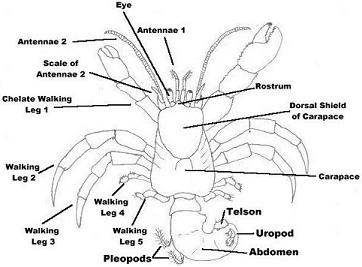Morphology

Diagram of a model decapod species.
(Courtesy E-Fauna BC © 2008)
To the trained eye, even a cursory examination of Yeti crab morphology places the species squarely within the superfamily Galatheoidea (also known by the common name of "squat lobsters"). Squat lobsters typically feature the following characteristics (Baba, et al. 2008):
- Bilaterally symmetrical body plan consisting of three body segments: cephalothorax, abdomen, and telson
- Five pairs of thoracic legs (pereopods): one pair of elongated chelipeds that terminate in pincers used for grasping; three pairs of walking legs; and one pair folded within its shell (carapace)
- A tail fan comprising its telson and a pair of spatulate appendages (uropods)
- In males only, additional abdominal appendages (pleopods), one or two pairs of which may be modified into copulatory structures (gonopods)
Male holotype K. hirsuta, dorsal and ventral views.
(Courtesy Zoosystema © 2005)
(Courtesy Zoosystema © 2005)
However, with respect to other species of squat lobsters, K. hirsuta exhibits a number of unusual characteristics that justify placing it within its own family, the Kiwaidae (Macpherson, et al. 2005):
- Unusual carapace shape and ornamentation
- Invisible fifth pereopod that must be dissected to be observed
- Large, strongly pronounced ventral thoracic plate (sternite), as opposed to the depressed abdomen typically seen in other squat lobsters
- Diminished, probably sightless eyes featuring only vestigial membranes with no obvious sight structures
- Thick matting of hairlike structures (setae) intertwined with clusters of filamentous bacteria on the chelipeds and walking legs.
Follow these links to learn about the digestive tract and cardiovascular system of decapods.